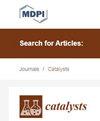Water Oxidation over Au-Pd/TiO2 as a Substitute for Iridium-Based Catalysts
IF 3.8
3区 化学
Q2 CHEMISTRY, PHYSICAL
引用次数: 0
Abstract
Water oxidation is one of the most important reactions needed for a transition to a green economy. The reaction relies on extracting electrons from oxygen anions and is commonly studied using homogenous catalysts based on Ru or Ir metals. Because of Ir scarcity and its relative instability in acidic environments, metals to replace it are sought after. In this study, we have synthesized Au-Pd-based catalysts deposited on TiO2 with different ratios in order to mimic IrO2 valence orbitals (Ir5d) by the hybrid valence orbitals of Au5d and Pd4d and compared their heterogeneous catalytic activity for the evolution of O2 from water in the presence of cerium ammonium nitrate (CAN). Au-Pd-based catalysts were found to be active at a particular nominal atomic ratio. At an atomic ratio of 1 Au to 2 Pd and 1 Au to 3 Pd, the catalysts were active and stable for oxygen production from water. Long-term runs up to 20,000 min still showed the expected stoichiometry between O2 production and CAN consumption (1 to 4). However, catalysts with a reverse ratio were not active. Also, the monometallic catalysts were found to be not active for the reaction. We link the reason for the activity of Au-Pd with this specific ratio to the shape and energy position of their valence band that might be similar to those of IrO2 particles. While the turnover numbers of the Au-Pd-based catalysts were found to be lower than those of IrO2-based catalysts, on the same support in a heterogenous system, there is considerable potential upon further optimization for these two metals to replace IrO2 for a water oxidation reaction.作为铱基催化剂替代物的 Au-Pd/TiO2 上的水氧化作用
水氧化是向绿色经济过渡所需的最重要反应之一。该反应依赖于从氧阴离子中提取电子,通常使用基于 Ru 或 Ir 金属的均质催化剂进行研究。由于 Ir 的稀缺性及其在酸性环境中的相对不稳定性,人们一直在寻找可以替代它的金属。在本研究中,我们以不同的比例合成了沉积在 TiO2 上的 Au-Pd 基催化剂,以便用 Au5d 和 Pd4d 的混合价轨道模拟 IrO2 价轨道(Ir5d),并比较了它们在硝酸铵铈(CAN)存在下从水中进化出 O2 的异相催化活性。研究发现,基于金钯的催化剂在特定的名义原子比下具有活性。在 1 金 2 钯和 1 金 3 钯的原子比条件下,催化剂对从水中制取氧气具有活性和稳定性。在长达 20,000 分钟的长期运行过程中,氧气产生量和 CAN 消耗量之间仍然存在预期的化学计量关系(1 比 4)。然而,比例相反的催化剂并不活跃。此外,我们还发现单金属催化剂在反应中也不活跃。我们将这种特定比例的 Au-Pd 具有活性的原因与其价带的形状和能量位置联系起来,它们可能与 IrO2 粒子的价带形状和能量位置相似。虽然在异质系统中的相同支持物上,发现 Au-Pd 基催化剂的周转次数低于 IrO2 基催化剂的周转次数,但经过进一步优化,这两种金属在取代 IrO2 进行水氧化反应方面具有相当大的潜力。
本文章由计算机程序翻译,如有差异,请以英文原文为准。
求助全文
约1分钟内获得全文
求助全文
来源期刊

Catalysts
CHEMISTRY, PHYSICAL-
CiteScore
6.80
自引率
7.70%
发文量
1330
审稿时长
3 months
期刊介绍:
Catalysts (ISSN 2073-4344) is an international open access journal of catalysts and catalyzed reactions. Catalysts publishes reviews, regular research papers (articles) and short communications. Our aim is to encourage scientists to publish their experimental and theoretical results in as much detail as possible. Therefore, there is no restriction on the length of the papers. The full experimental details must be provided so that the results can be reproduced.
 求助内容:
求助内容: 应助结果提醒方式:
应助结果提醒方式:


